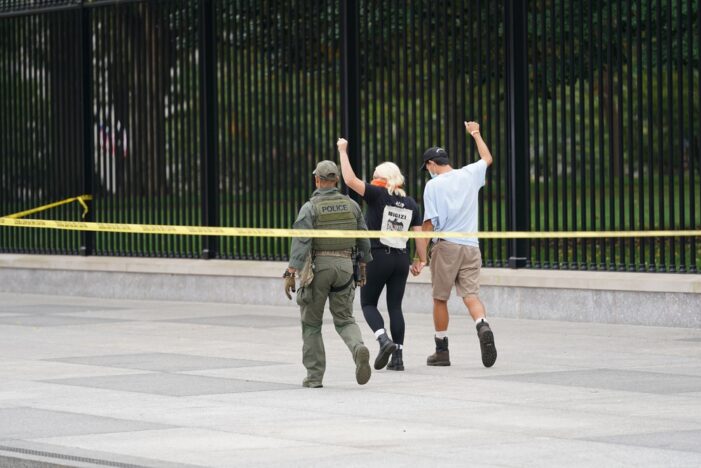By: Dara Lind | americanimmigrationcouncil.org| Editorial credit: Phil Pasquini / Shutterstock.com
One week into the federal takeover of Washington, D.C., it’s becoming increasingly clear that this is yet another front in the Trump administration’s war on immigrants and the communities that welcome them.
The Trump administration’s 30-day federalization of the capital and mobilization of the D.C. National Guard is under the pretext of fighting violent crime – and has been attacked both as political theatre and as a militarized occupation of an American city. But in addition to being a symbolic fight, the D.C. takeover has become a way for the federal government to undo D.C. laws protecting immigrants and force local police to support ICE. And lives and neighborhoods are being ruined as a result.
What’s Happening in D.C.?
To understand what’s going on in D.C., it’s important to know that there are two distinct components to the federal takeover. One is the deployment of the National Guard – now including six states and counting, in addition to the D.C. guard – that is similar to what we saw in Los Angeles earlier this summer, with National Guard troops being used as a force multiplier to intimidate immigrants and their neighbors and carry out a “show of force” in areas with high visibility. But the second, unique to D.C. and arguably more important, is the Trump administration’s use of the takeover to change rules about how the D.C. police operate. This has allowed the administration to redirect local cops’ efforts not toward solving or preventing crime but toward rounding up delivery drivers and setting up ICE-staffed checkpoints.
On the night of August 10th, it was reported that the federal government would order the D.C. National Guard to mobilize in the District for the (supposed) purposes of violent crime prevention. A week later – despite there being no conflict with National Guard agents or any other form of escalation – Republican governors began to announce they would send Guard deployments to D.C. as well. As of Wednesday, August 20th, Louisiana, Mississippi, Ohio, South Carolina, Tennessee, and West Virginia have all sent or pledged to send Guard troops. In total, an estimated 800 D.C. Guard units have been mobilized, and 1,100 state Guard troops.
This is reminiscent of what happened in Los Angeles in June, when the Trump administration (arguably illegally) mobilized the California National Guard over the objections of the state’s governor. In the case of LA, DHS (including both ICE and the Border Patrol) started conducting sweeping immigration raids at the same time; and then when Angelenos protested and confronted agents, the administration used the “rioting” as justification to send in the Guard.
What Is the National Guard Doing in D.C.?
In D.C., the purported justification for the Guard is unrelated to immigration.
Guard units have been seen in heavily-touristed parts of D.C. – which aren’t exactly violent crime hotspots. Their presence is seen as an act of theatre: a way to create visuals that make Trump look tough, and – not incidentally – make us DCers feel like our city doesn’t belong to us.
Crucially, in LA, Guard units served as “force protection” on ICE operations – essentially providing extra manpower, with guns, to further intimidate immigrants and anyone who might want to stand up for them. This blurs the line between policing, military operations, and immigration enforcement. And it’s yet another example of the Trump administration remaking the entire government into a deportation machine: alongside Guard units and ICE agents in California were employees of other federal law enforcement agencies, from the DEA to the FBI, pulled off their own missions to help round up gardeners and day laborers.
That’s not primarily what’s going on in D.C. The other federal law enforcement agents are alongside ICE, but the crucial added ingredient here hasn’t been the Guard – it’s been the DC Metro Police Department. That brings us to the second part of what’s happening in D.C. – which is less showy but, arguably, more important for residents of the District.
Why Are ICE and Federal Law Enforcement Working with Washington, D.C. Police?
Last Monday, President Trump formally invoked a provision of D.C.’s Home Rule Charter (which gives the District some degree of local control over its own operations) that allows a 30-day federal takeover of city policing. Specifically, the provision allows the president to tell the District mayor to provide “such services of the Metropolitan Police force as the President may deem necessary and appropriate” – and the mayor has to do it.
On Thursday, the head of the MPD issued a directive telling local police to share information with ICE about residents who might be undocumented in certain circumstances – but then, on Thursday night, Attorney General Pam Bondi announced the head of MPD was being replaced (with the head of the federal Drug Enforcement Administration named “acting” chief instead) and that all policies restricting local cooperation with ICE were now repealed. After the District sued, Bondi walked this back; a Friday night directive reinstated the head of the MPD, but also directed the cops (via the mayor) to assist ICE with enforcement operations and comply with any request for information or database access.
What Have Federal Agents Been Seen Doing in D.C.?
Every day since the federal takeover, DC residents have posted videos of federal agents – often with a mix of uniforms or no official badges at all – in patrols, staffing checkpoints, or going after people. And the people they’ve been going after have largely been (apparent) immigrants. One video over the weekend showed agents violently arresting a delivery biker in the U Street neighborhood of D.C.; on Monday, ICE and the MPD were together at a driver checkpoint in Northeast. Other checkpoints have been set up in heavily-trafficked areas, including near U Street, a neighborhood known for bars and restaurants.
These operations are often happening more quietly than the militarized, showy Guard deployment. They aren’t the operations of a police department that’s cracking down on crime – violent or otherwise. They are immigration enforcement operations, pure and simple. Of course, to the Trump administration, all immigrants are violent criminals – but the rest of us know better, and residents of the District have tried to stand up to protect their neighbors. (In the Mount Pleasant neighborhood, ICE agents posted a video of themselves tearing down an anti-ICE banner in a plaza; new banners sprung up the next day.)It’s important to acknowledge that the federal government has used the takeover to change policies that limited local cooperation with immigration enforcement – instead of policies related to violent crime. These “sanctuary” policies have been a target of the Trump administration since its first term, but most of the levers they’ve tried to pull to force cities and states to cooperate with the feds haven’t been successful. Because the federal government has more control over D.C. than it does over actual states, they’re using the 30-day takeover to accomplish what they haven’t been able to do to LA or other cities. This is exactly the sort of thing that we’re used to seeing from this administration, which will use any and every tool at its disposal to go after immigrants; Stephen Miller, the impresario of this technique, went to MPD headquarters last week.
What Are the Consequences of Federal Immigration Enforcement in Washington, D.C.?
Unlike the Guard deployment, the 30-day takeover isn’t something the feds can easily replicate in other major cities. But it’s having an enormous impact on the District. According to the White House, over 40% of the 300 people arrested in the first week of the District takeover were purported unauthorized immigrants. Chilling effects have turned neighborhoods like Mount Pleasant into shadows of their pre-takeover selves, as people are afraid to go to restaurants, concerts, or work.
Even if the federal government readily cedes control of the police back to the District in 30 days, the people they’ve arrested and sent to ICE in the meantime will still be detained in inhumane, overcrowded facilities (if they haven’t simply accepted deportation). And the fear and chaos of the surge operation will likely continue to intimidate the over 1.5 million immigrants who live in the DC metro area, just as we’ve seen in LA. It’s symbolic, but it’s really important not to let the symbols distract us from the lives that are being destroyed.

